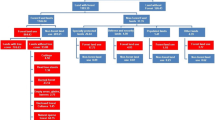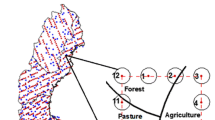Abstract
Urban areas are continuously expanding today, extending their influence on an increasingly large proportion of woods and trees located in or nearby urban and urbanizing areas, the so-called urban forests. Although these forests have the potential for significantly improving the quality the urban environment and the well-being of the urban population, data to quantify the extent and characteristics of urban forests are still lacking or fragmentary on a large scale. In this regard, an expansion of the domain of multipurpose forest inventories like National Forest Inventories (NFIs) towards urban forests would be required. To this end, it would be convenient to exploit the same sampling scheme applied in NFIs to assess the basic features of urban forests. This paper considers approximately unbiased estimators of abundance and coverage of urban forests, together with estimators of the corresponding variances, which can be achieved from the first phase of most large-scale forest inventories. A simulation study is carried out in order to check the performance of the considered estimators under various situations involving the spatial distribution of the urban forests over the study area. An application is worked out on the data from the Italian NFI.
Similar content being viewed by others
References
Alberti, M., Marzluff, J. M., Shulenberger, E., Bradley, G., Ryan, C., & Zumbrunnen, C. (2003). Integrating humans into ecology: Opportunities, challenges for studying urban ecosystems. Bioscience, 53(12), 1169–1179. doi:10.1641/0006-3568.
Baffetta, F., Fattorini, L., & Corona, P. (2011). Estimation of woodlot and tree row attributes in large-scale forest inventories. Environmental and Ecological Statistics, 18, 147–167. doi:10.1007/s10651-009-0125-0.
Barabesi, L., & Franceschi, S. (2010). Sampling properties of spatial total estimators under tessellation stratified designs. Environmetrics, on-line. doi:10.1002/env.1046.
Corona, P., & Marchetti, M. (2007). Outlining multi-purpose forest inventories to assess the ecosystem approach in forestry. Plant Biosystems, 141(2), 243–251. doi:10.1080/1126350070140183.
De Natale, F., & Gasparini, P. (Eds). (2003). Manuale di fotointerpretazione per la classificazione delle unità di campionamento di prima fase. Trento: INFC, CFS, CRA-ISAFA.
Dwyer, J. F., Nowak, D. J., Noble, M. H., & Sisinni, S. M. (2000). Connecting people with ecosystems in the 21st century: An assessment of our nation’s urban forests. Gen. Tech. Rep. PNW-GTR-400. Portland, OR: U. S. Department of Agriculture. Forest Service, Pacific Northwest Research Station.
EEA (2006). Urban sprawl in Europe. The ignored challenge. Luxembourg: Office for Official Publications of the European Communities.
FAO (2001). Global forest resources assessment 2000. Main report. Rome: Food and Agriculture Organization of the United Nations.
FAO (2010). Global forest resources assessment 2010. Main report. Rome: Food and Agriculture Organization of the United Nations.
Fattorini, L., Marcheselli, M., & Pisani, C. (2006). A three-phase sampling strategy for large-scale multiresource forest inventories. Journal of Agricultural, Biological, and Environmental Statistics, 11(3), 296–316. doi:10.1198/108571106X130548.
Hassan, R., Scholes, R., & Ash, N. (Eds.) (2005). Ecosystems and human well-being: Current state and trends. Millenium ecosystems assessment (Vol. 1). Washington: Island.
INFC (2007). Le stime di superficie 2005. Inventario Nazionale delle Foreste e dei Serbatoi Forestali di Carbonio. MiPAF—Ispettorato Generale Corpo Forestale dello Stato, CRA-ISAFA, Trento.
ISTAT, Indicatori ambientali urbani. Tavole verde urbano (2000, 2001, 2002, 2003, 2004, 2005, 2006, 2007). http://www.istat.it/dati/dataset/20051125_00.
Kleinn, C. (2002). New technologies and methodologies for national forest inventories. Unasylva, 210(53), 10–15.
Konijnendijk, C. C. (1999). Urban forestry in Europe: A comparative study of concepts, policies and planning for forest conservation, management and development in and around major european cities. Academic dissertation, Faculty of Forestry, University of Joensuu.
Konijnendijk, C. C. (2003). A decade of urban forestry in Europe. Forest Policy and Economics (Elsevier), 5(2), 173–186. doi:10.1016/S1389-9341(03)00023-6.
Konijnendijk, C. C., Ricard, R. M., Kenney, A., & Randrup T. B. (2006). Defining urban forestry—A comparative perspective of North America and Europe. Urban Forestry & Urban Greening, 4(3–4), 93–103. doi:10.1016/j.ufug.2005.11.003.
Maricchiolo, C., Sambucini, V., Pugliese, A., Munafò, M., Cecchi, G., Rusco, E., et al. (2005). La realizzazione in Italia del progetto europeo Corine Land Cover 2000. Rapporti APAT 61, Roma.
Marzluff, J. M., & Ewing, K. (2001). Restoration of fragmented landscape for the conservation of birds: A general framework and specific recommendations for urbanizing landscapes. Restoration Ecology, 9(3), 280–292. doi:10.1007/978-0-387-73412-5_48.
Nowak, D. J. (2008). Assessing urban forest structure: Summary and conclusions. Arboriculture & Urban Forestry, 34(6), 391–392.
Nowak, D. J., Twardus, D., Hoehn, R., Mielke, M., Walton, J. T., Crane, D. E., et al. (2004). Urban forest health monitoring in the United States. In Proceedings of the sixth annual forest inventory and analysis symposium.
Riemann, R. (2003). Pilot inventory of FIA plots traditionally called ‘Nonforest’. USDA Forest Service, Northeastern Res. St. Gen. Tech. Rep. NE-312.
Riemann, R., & Birch, T. (1996). Method for identifying urban forest from forest inventory and analysis data. In L. Abrahamson, W. Aikman, R. Whaley, & B. Blackmon (Eds.), Proceedings of the conference: The Empire Forest—Changes and challenges, Syracuse, NY, 13–14 November 1995 (pp. 59–71). NY: Syracuse.
Sanesi, G., Padoa-Schioppa, E., Lorusso, L., Bottoni, L., & Lafortezza, R. (2009). Avian ecological diversity as an indicator of urban forest functionality. Results from two case studies in Northern and southern Italy. Arboriculture & Urban Forestry, 35(2), 80–86.
Särndal, C. E., Swensson, B., & Wretman, J. (1992). Model assisted survey sampling. New York: Springer.
Schreuder, H. T., Gregoire, T. G., & Wood, G. B. (1993). Sampling methods for multiresources forest inventory. New York: Wiley.
Shaw, J. D. (2008). Benefit of a strategic national forest inventory to science and society: The USDA forest service forest inventory and analysis program. iForest, 1, 81–85. doi:10.3832/ifor0345-0010081.
Stevens, D. L. (1997). Variable density grid-based sampling designs for continuous spatial populations. Environmetrics, 8, 167–195.
Author information
Authors and Affiliations
Corresponding author
Rights and permissions
About this article
Cite this article
Corona, P., Agrimi, M., Baffetta, F. et al. Extending large-scale forest inventories to assess urban forests. Environ Monit Assess 184, 1409–1422 (2012). https://doi.org/10.1007/s10661-011-2050-6
Received:
Accepted:
Published:
Issue Date:
DOI: https://doi.org/10.1007/s10661-011-2050-6




